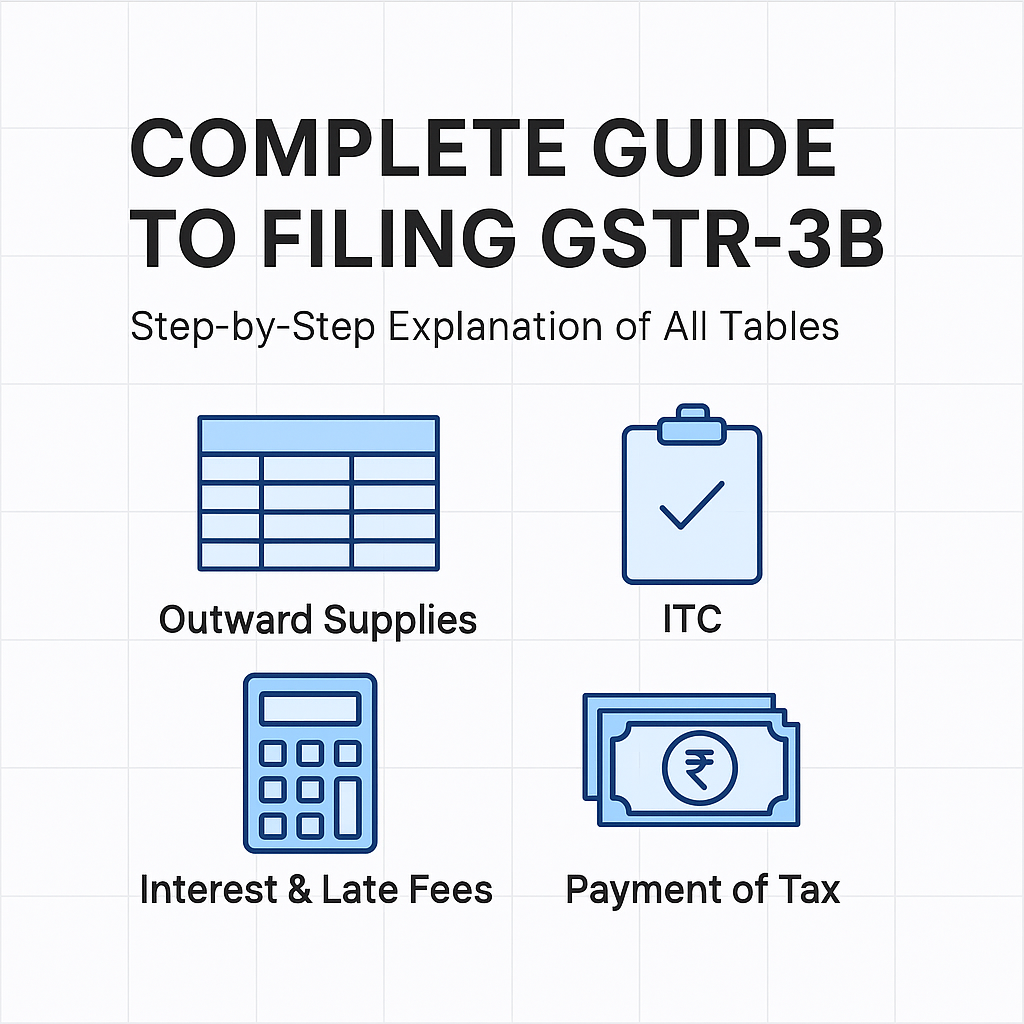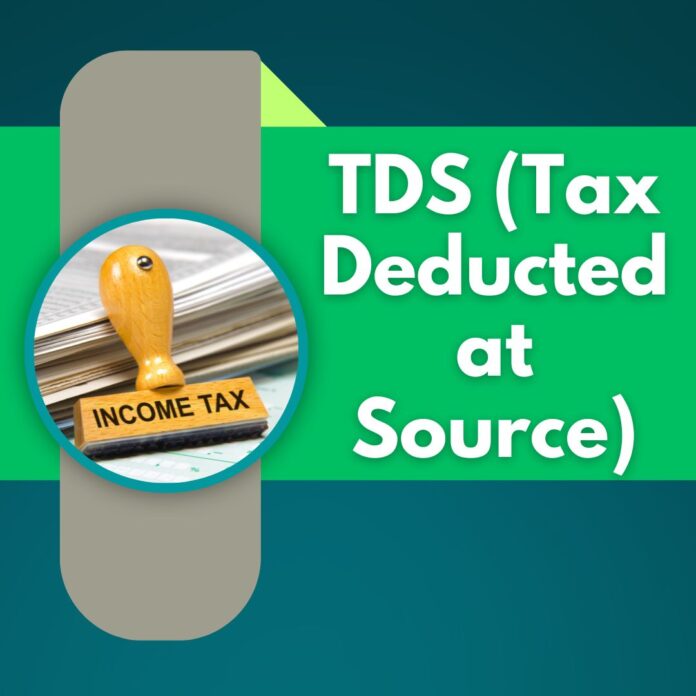Complete Guide to Filling GSTR-3B: Understanding Tables 3.1, 3.1.1, 3.2, ITC, and Tax Payment
GSTR-3B is a self-declared monthly/quarterly summary return under GST, where taxpayers report their outward supplies, inward supplies, input tax credit (ITC), and payment of taxes.
This guide explains key sections and tables of GSTR-3B, including auto-population from GSTR-1 and GSTR-2B, refund guidelines for exports, and reporting under special provisions like Section 9(5).
1. Table 3.1 – Details of Outward Supplies and Inward Supplies Liable to Reverse Charge
In this table, taxpayers must report taxable outward supplies and inward supplies on which reverse charge applies (other than those covered in Table 3.1.1).
Breakdown of Table 3.1
| Sl. No. | Nature of Supplies | Auto-drafted from | Key Notes |
| (a) | Outward taxable supplies (other than zero-rated, nil-rated, exempted) | GSTR-1 | Report domestic taxable sales. |
| (b) | Outward taxable supplies (zero-rated) | GSTR-1 | Report exports and supplies to SEZ with payment of IGST. |
| (c) | Other outward supplies (nil-rated, exempted) | GSTR-1 | Include non-taxable sales. |
| (d) | Inward supplies liable to reverse charge | GSTR-2B | Report purchases on which you pay GST under RCM. |
| (e) | Non-GST outward supplies | GSTR-1 | Supplies not covered under GST law. |
Important Refund Guideline for IGST Paid on Exports
- IGST on exports of goods/services or supplies to SEZ must be reported in Table 3.1(b) only.
- If IGST is incorrectly reported under Table 3.1(a) or (c), invoices will not be transmitted to ICEGATE, delaying refunds.
2. Table 3.1.1 – Supplies Notified Under Section 9(5) of CGST Act
Section 9(5) covers cases where the e-commerce operator is liable to pay tax, not the supplier.
Table 3.1.1 captures such transactions in two parts:
| Sl. No. | Description | To be Furnished By |
| (i) | Taxable supplies where e-commerce operator pays tax u/s 9(5) | E-commerce operator |
| (ii) | Supplies made through e-commerce operator on which operator is liable to pay u/s 9(5) | Registered supplier |
Examples under Section 9(5) include online cab services, hotel bookings (below tariff limit), housekeeping services via portals, etc.
3. Table 3.2 – Inter-State Supplies to Unregistered Persons, Composition Taxpayers, and UIN Holders
This section is a breakup of 3.1(a) and 3.1.1(i), showing place-wise details of inter-state supplies.
Categories to Report
- Supplies to Unregistered Persons – Report state-wise sales to consumers without GST registration.
- Supplies to Composition Taxable Persons – State-wise supplies to GST composition scheme dealers.
- Supplies to UIN Holders – Sales to embassies, UN bodies, etc.
4. Table 4 – Eligible Input Tax Credit (ITC)
This table is mostly auto-populated from GSTR-2B, except for certain adjustments.
Structure of Table 4
(A) ITC Available
- Import of goods
- Import of services
- Inward supplies liable to reverse charge (other than imports)
- ITC from Input Service Distributor (ISD)
- All other ITC (domestic purchases)
(B) ITC Reversed
- As per rules 38, 42, 43 and blocked credit under section 17(5)
- Other reversals (e.g., non-payment to supplier within 180 days)
(C) Net ITC Available
- ITC available after reversal.
(D) Other Details
- ITC reclaimed (earlier reversed)
- Ineligible ITC under section 16(4) & POS rules
5. Table 5 – Exempt, Nil-Rated, and Non-GST Inward Supplies
Here, you report purchases (inter-state and intra-state) which are exempt, nil-rated, or non-GST.
Examples:
- Purchases from composition dealers
- Electricity (non-GST supply)
- Agricultural produce
6. Table 5.1 – Interest and Late Fee for Previous Period
If you have pending interest or late fees for earlier tax periods, report them here:
- Interest – Payable on late payment of GST, including RCM liabilities.
- Late Fee – ₹25/day per Act (CGST & SGST) if liability exists, ₹10/day if nil return.
7. Table 6.1 – Payment of Tax
This table shows:
- Cash Ledger Balance
- Credit Ledger Balance
- Tax Payable and Utilization Pattern
Key Points:
- The system auto-calculates ITC utilization as per GST law.
- If cash balance is insufficient, you must generate a challan for the remaining amount.
- Liability must be fully discharged before filing GSTR-3B.
Filing GSTR-3B accurately is crucial to avoid:
- Late fees and penalties
- Refund delays (especially for IGST on exports)
- Mismatches with GSTR-1 and GSTR-2B
Always verify auto-populated details, make necessary corrections, and maintain supporting documentation.
Advisory: File Pending GST Returns Before 3-Year Expiry (Updated June 18th, 2025)
As per the Finance Act, 2023 (8 of 2023) dated 31-03-2023, and implemented w.e.f. 01-10-2023 via Notification No. 28/2023 – Central Tax dated 31st July, 2023, taxpayers will not be allowed to file their GST returns after three years from the due date of furnishing such returns under:
- Section 37 – Outward Supply
- Section 39 – Payment of Liability
- Section 44 – Annual Return
- Section 52 – Tax Collected at Source
These sections cover the following GST return forms: GSTR-1, GSTR-1A, GSTR-3B, GSTR-4, GSTR-5, GSTR-5A, GSTR-6, GSTR-7, GSTR-8, GSTR-9, and GSTR-9C.
Key Points of the Advisory
- This restriction will be implemented on the GST portal from August 2025 tax period.
- Any return whose due date was three years ago or more and is still pending will be barred from filing.
- A prior advisory on this matter was issued by GSTN on October 29th, 2024.
Illustration of Barred Returns from 1st September 2025
| GST Form | Barred Period (w.e.f. 1st September 2025) |
| GSTR-1/IFF | July 2022 |
| GSTR-1Q | April–June 2022 |
| GSTR-3B/M | July 2022 |
| GSTR-3BQ | April–June 2022 |
| GSTR-4 | FY 2021–22 |
| GSTR-5 | July 2022 |
| GSTR-6 | July 2022 |
| GSTR-7 | July 2022 |
| GSTR-8 | July 2022 |
| GSTR-9/9C | FY 2020–21 |
Action for Taxpayers:
If you have any pending GST returns for the above-mentioned periods, reconcile your records and file them immediately to avoid being permanently barred from filing.
Advisory: Auto-Populated Tax Liability in GSTR-3B Will Soon Be Non-Editable (Updated June 7th, 2025)
Currently, when you file your GSTR-3B, the tax liability (the GST you owe) is auto-filled on the GST portal based on the sales you’ve already reported in GSTR-1, GSTR-1A, or IFF. Right now, you can still edit those auto-filled numbers in GSTR-3B if needed.
From July 2025 tax period (returns to be filed in August 2025), this will change:
- The auto-populated liability in GSTR-3B will no longer be editable.
- If you’ve made a mistake in GSTR-1 or IFF, you must correct it through GSTR-1A for the same tax period before filing your GSTR-3B.
- GSTR-1A allows you to amend wrongly declared outward supplies so your tax liability is fixed at the source before it appears in GSTR-3B.
Why This Change?
This is being done to improve accuracy and prevent mismatches between GSTR-1 and GSTR-3B, reducing the chances of disputes, penalties, or GST notices.
Action for Taxpayers
- Double-check your GSTR-1/IFF entries before the GSTR-3B due date.
- If you find an error, use GSTR-1A to amend it in the same period.
- Once GSTR-3B is ready, you won’t be able to adjust the liability directly inside the form.
For more details, refer to the GSTN advisories dated January 27th, 2025 and October 17th, 2024.




